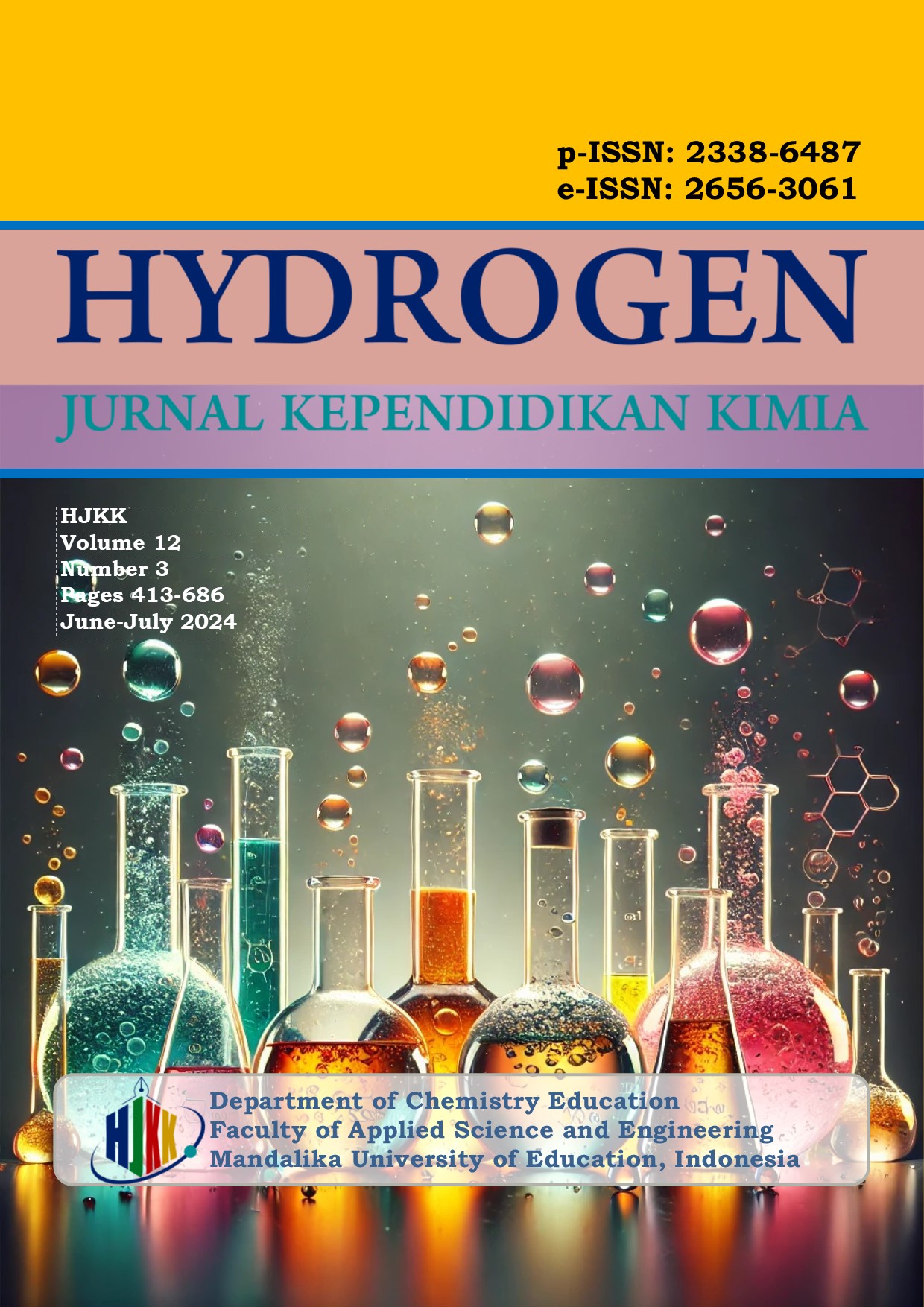Kinetics of Tofu Pulp as Copper Metal Adsorbent on the Waste of the Silver Craft Industry
DOI:
https://doi.org/10.33394/hjkk.v12i3.12462Keywords:
tofu dregs, adsorption, silver craft industry, copper metalAbstract
References
Apriliani. (2010). Pemanfaatan Arang dari Ampas Tebu Sebagai Adsorben Ion Logam Cd, Cr, Cu, dan Pb dalam Air Limbah. Skripsi. Universitas Islam Negeri Syarif Hidayatullah.
Chandra, T.C., Mirna, M.M., Sudaryanto, Y., Ismadji, S. (2017). Adsorption of Basic Dye onto Carbon prepared from Durian Shell: Studies of Adsorption Equilibrium and Kinetics. Chem. Eng. Journal.127(1), 121 -129
Chung, K.-T. (2016). Azo Dyes and Human Health: A review. Journal of Environmental Science and Health, Part C. 34, 233–361
Coniwati., A. Herlanto dan I. Anggraini. (2009). Pembuatan Biogas dan Ampas Tahu. Jurnal Teknik Kimia. 1(16), 39-48
Crini, G. (2016). Non-Conventional LowCost Adsorbents for Dyes Removal A Review. Bioresour. Technol.97(9), 1061–1085
Dotto, G. L., Vieira, M. L. G., Pinto, L. A. A. (2012). Kinetics and Mechanism of Tartrazine Adsorption onto Chitin and Chitosan. Ind. Eng. Chem. Res. 51, 6862–6868
Handoko, C.T., Yanti, T.B., Syadiyah, H., dan Marwati, S. (2013). Penggunaan Metode Presipitasi Untuk Menurunkan Kadar Cu dalam Limbah Cair Industri Perak di Kotagede. Jurnal Penelitian Saintek. 18 (2), 51-58.
https://travel.kompas.com/read/2017/05/24/15510540/Desa.Ungga.Sohor.karena.Kerajinan.Perak. Retrieved Maret 11, 2021.
Indah, D.R. dan Hendrawani. (2017). Upaya Menurunkan Kadar Ion Logam Besi pada Air Sumur Dengan Memanfaatkan Arang Ampas Tebu. Hydrogen : Jurnal Kependidikan Kimia. 5(2), 68-74.
Indah, D.R. dan Safnowandi, S. (2020). Karakterisasi Karbon Baggase Teraktivasi dan Aplikasinya untuk Adsorpsi Logam Tembaga. Hydrogen : Jurnal Kependidikan Kimia. 7(2), 46-54.
Indah, D.R. dan Hulyadi, H. (2021) .Penyerapan Logam Merkuri Menggunakan Karbon Terinterkalasi EDTA. Jurnal Ilmiah IKIP Mataram. 8(1), 76-85.
Manocha, S. M. (2013). Porous Carbons. Jurnal Sadhana. Vol. 28, part 1 dan 2.
Nohong. (2012). Pemanfaatan Limbah Tahu Sebagai Bahan Penyerap Logam Krom, Kadmium dan Besi dalam Air Lindi TP. Jurnal Pembelajaran Sains. 6(2), 257-269
Notoatmodjo, S. (2010). Metode Penelitian Kesehatan. Jakarta: Rineka Cipta
Nugroho, D. (2013). Pemanfaatan Limbah Padat Industri Tahu dan Reaktor Biosand Filter untuk Menurunkan Kadar Ion Logam Fe3+dan Zn2+ pada Industri Galvanis. Skripsi. Universitas Negeri Semarang
Palar, H. (2012). Pencemaran dan Toksikologi Logam Berat. Jakarta : Rineka Cipta.
Rafatullah, M., Sulaiman, O., Hashim, R., Ahmad, A. (2010). Adsorption of methylene blue on low-cost adsorbents: a review. J. Hazard. Mater.177(1), 70–80
Roto, R., Indah, D.R., dan Kuncaka, A. (2015). Hydrotalsit Zn-Al-EDTA Sebagai Adsorben Untuk Polutan Ion Pb (II) di Lingkungan. Jurnal Manusia dan Lingkungan. 22 (2), 226-232.
Selvi, K., Pattabhi S and Kardivelu K. (2011). Removal of Cr(VI) from Aqueous Solution by Adsorption Onto Activated Carbon. Bioresour Technol. Vol 80, 87-89.
Shofa. (2012). Pembuatan Karbon Aktif Berbahan Baku Ampas Tebu dengan Aktivasi Kalium Hidroksida. Skripsi. Jakarta : Fakultas Teknik Kimia Universitas Indonesia.
Sulistyawati, S. (2008). Modifikasi Tongkol Jagung Sebagai Adsorben Logam Berat Pb (II). Skripsi. Bogor : FMIPA IPB.
Tanasale, M.F.J.D.P., Sutapa, I W., Topurtawy, R.R. (2014). Adsorpsi Zat Warna Rhodamin B oleh Karbon Aktif dari Kulit Durian (Durio zibethinus). Indo. J. Chem. Res.2(1), 116 – 121
Taufieq, N.A.S. (2011). Pemanfaatan Zeolit dan Bokashi Ampas Tahu untuk Menekan Konsentrasi Logam Berat pada Tanah Podsolik Merah Kuning di Soroako. Jurnal Chemica. 11(1), 9-14
Tripathi, A. dan M. R. Ranjan. (2015). Heavy Metal Removal from Wastewater Using Low Cost Adsorbents. Jurnal Bioremed Biodeg. 6(1), 80-87
Wan Ngah, W. S., Ariff, N. F. M., Hanafiah, M.A.K.M. (2010). Preparation, Characterization, and Environmental Application of Crosslinked Chitosan-Coated Bentonite for Tartrazine Adsorption from Aqueous Solutions. Water Air Soil Pollut. 206, 225–236
Widihati, I. A. G., Suastuti, N. G. A. M. D. A., Nirmalasari M. A. Y. (2012). Studi Kinetika Adsorpsi Larutan Ion Logam Kromium (Cr) menggunakan Arang Batang Pisang (Musa paradisiaca). Jurnal Kimia. 6(1), 8-16.
Downloads
Published
How to Cite
Issue
Section
Citation Check
License
License and Publishing Agreement
In submitting the manuscript to the journal, the authors certify that:
- They are authorized by their co-authors to enter into these arrangements.
- The work described has not been formally published before, except in the form of an abstract or as part of a published lecture, review, thesis, or overlay journal.
- That it is not under consideration for publication elsewhere,
- That its publication has been approved by all the author(s) and by the responsible authorities – tacitly or explicitly – of the institutes where the work has been carried out.
- They secure the right to reproduce any material that has already been published or copyrighted elsewhere.
- They agree to the following license and publishing agreement.
Copyright
Authors who publish with Hydrogen: Jurnal Kependidikan Kimia agree to the following terms:
- Authors retain copyright and grant the journal right of first publication with the work simultaneously licensed under a Creative Commons Attribution License (CC BY-SA 4.0) that allows others to share the work with an acknowledgment of the work's authorship and initial publication in this journal.Â
- Authors are able to enter into separate, additional contractual arrangements for the non-exclusive distribution of the journal's published version of the work (e.g., post it to an institutional repository or publish it in a book), with an acknowledgment of its initial publication in this journal.
- Authors are permitted and encouraged to post their work online (e.g., in institutional repositories or on their website) prior to and during the submission process, as it can lead to productive exchanges, as well as earlier and greater citation of published work.
Licensing for Data Publication
Hydrogen: Jurnal Kependidikan Kimia uses a variety of waivers and licenses, that are specifically designed for and appropriate for the treatment of data: Open Data Commons Attribution License, http://www.opendatacommons.org/licenses/by/1.0/ (default) Other data publishing licenses may be allowed as exceptions (subject to approval by the editor on a case-by-case basis) and should be justified with a written statement from the author, which will be published with the article.







